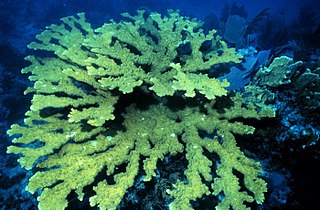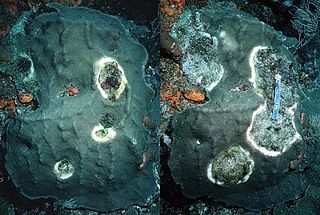
Black band disease is a coral disease in which corals develop a black band. It is characterized by complete tissue degradation due to a pathogenic microbial consortium. The mat is present between apparently healthy coral tissue and freshly exposed coral skeleton.

The staghorn coral is a branching, stony coral with cylindrical branches ranging from a few centimetres to over two metres in length and height. It occurs in back reef and fore reef environments from 0 to 30 m depth. Wave forces dictate the upper threshold, while suspended sediments and the availability of light regulate the lower boundary. Until the mid-1980s, the intermediate depths of 5–25 meters in the fore reef zones were once primarily occupied by vast areas of staghorn coral, consisting largely of single-species stands. This coral exhibits the fastest growth of all known western Atlantic fringe corals, with branches increasing in length by 10–20 cm (3.9–7.9 in) per year. This has been one of the three most important Caribbean corals in terms of its contribution to reef growth and fishery habitat.

Elkhorn coral is an important reef-building coral in the Caribbean. The species has a complex structure with many branches which resemble that of elk antlers; hence, the common name. The branching structure creates habitat and shelter for many other reef species. Elkhorn coral is known to grow quickly with an average growth rate of 5 to 10 cm per year. They can reproduce both sexually and asexually, though asexual reproduction is much more common and occurs through a process called fragmentation.
Skeletal eroding band (SEB) is a disease of corals that appears as a black or dark gray band that slowly advances over corals, leaving a spotted region of dead coral in its wake. It is the most common disease of corals in the Indian and Pacific Oceans, and is also found in the Red Sea.

The Florida Reef is the only living coral barrier reef in the continental United States. It lies a few miles seaward of the Florida Keys, is about 4 miles wide and extends 270 km (170 mi) from Fowey Rocks just east of Soldier Key to just south of the Marquesas Keys. The barrier reef tract forms a great arc, concentric with the Florida Keys, with the northern end, in Biscayne National Park, oriented north-south and the western end, south of the Marquesas Keys, oriented east-west. The rest of the reef outside Biscayne National Park lies within John Pennekamp Coral Reef State Park and the Florida Keys National Marine Sanctuary. Isolated coral patch reefs occur northward from Biscayne National Park as far north as Stuart, in Martin County. Coral reefs are also found in Dry Tortugas National Park west of the Marquesas Keys. There are more than 6,000 individual reefs in the system. The reefs are 5,000 to 7,000 years old, having developed since sea levels rose following the Wisconsinan glaciation.

White pox disease, first noted in 1996 on coral reefs near the Florida keys, is a coral disease affecting Elkhorn coral throughout the Caribbean. It causes irregular white patches or blotches on the coral that result from the loss of coral tissue. These patches distinguish white pox disease from white band disease which produces a distinctive white band where the coral skeleton has been denuded. The blotches caused by this disease are also clearly differentiated from coral bleaching and scars caused by coral-eating snails. It is very contagious, spreading to nearby coral.

Yellow-band disease is a coral disease that attacks colonies of coral at a time when coral is already under stress from pollution, overfishing, and climate change. It is characterized by large blotches or patches of bleached, yellowed tissue on Caribbean scleractinian corals.

Acropora prolifera, the fused staghorn coral, is a branching, colonial, stony coral found in shallow parts of the Caribbean Sea, the Bahamas and southern Florida.

Acropora pulchra is a species of colonial staghorn coral in the family Acroporidae. It is found on the back fringes of reefs in shallow water in the western Indo-Pacific Ocean. The oldest fossils of this species date back to the Pleistocene.

Acropora muricata, commonly called staghorn coral, is a species of acroporid coral found in the Gulf of Aden, the Red Sea, Indian Ocean, Persian Gulf, Australia, central Indo-Pacific, Japan, Southeast Asia, the East China Sea and the oceanic central and western Pacific Ocean. It is found in tropical shallow reefs, slopes of reefs, and in lagoons, from depths of 5 to 30 m. It was described by Dana in 1846.
Acropora dendrum is a species of acroporid coral that was first described by Bassett-Smith in 1890. Found in tropical, shallow reefs in areas of powerful waves at depths of 5 to 20 m, it is threatened by disease. The species is rated as vulnerable on the IUCN Red List, with a decreasing population. It is not common but found over a large area, and is listed on CITES Appendix II.
Acropora derawanensis is a species of acroporid coral that was first described by Carden Wallace in 1997. Found in tropical, shallow reefs sheltered from the waves in a marine environment, it is found at depths of 10 to 25 m on reef slopes. The species is rated as vulnerable on the IUCN Red List, with a decreasing population. It is not common but found over a large area, and is listed on CITES Appendix II. It is easily damaged.

Acropora donei is a species of acroporid coral that was first described by J. Veron and Carden Wallace in 1984. Found in fringing reefs and the upper slopes of shallow reefs, it occurs at depths of 5 to 20 m. The species is rated as vulnerable on the IUCN Red List, with a decreasing population, and is affected by disease. It is not common but found over a large area, and is listed under CITES Appendix II.
Acropora kirstyae is a species of acroporid coral that was first described by Jen Veron and C. C. Wallace in 1984. Found in marine, tropical, shallow reefs in sheltered areas usually at depths of 10 to 25 m, and also occurs in sheltered lagoons. It is listed as a vulnerable species on the IUCN Red List, and it is thought to have a decreasing population. It is not common and found over a large area, and is listed on CITES Appendix II.
Acropora kosurini is a species of acroporid coral that was first described by C. C. Wallace in 1994. Found in marine, shallow reefs, it occurs at depths of 8 to 20 m. It is listed as a vulnerable species on the IUCN Red List, and it is believed to have a decreasing population. It is rare but found over a large area, and is listed on CITES Appendix II.

A corallivore is an animal that feeds on coral. Corallivores are an important group of reef organism because they can influence coral abundance, distribution, and community structure. Corallivores feed on coral using a variety of unique adaptations and strategies. Known corallivores include certain mollusks, annelids, fish, crustaceans, flatworms and echinoderms. The first recorded evidence of corallivory was presented by Charles Darwin in 1842 during his voyage on HMS Beagle in which he found coral in the stomach of two Scarus parrotfish.
Coral diseases are transmissible pathogens that cause the degradation of coral colonies. Coral cover in reef ecosystems has decreased significantly for a diverse set of reasons, ranging from variable environmental conditions to mechanical breakdowns from storms. In recent years, diseases that infect and kill coral have shown to be a threat to the health of coral reefs. Since the first coral disease was reported in 1965, many different kinds of diseases have popped up in mostly Caribbean waters. These diseases are diverse, including pathogens of bacteria, fungi, viruses, and protozoans. Coral diseases have widespread implications, impacting entire ecosystems and communities of organisms. Researchers are working to understand these diseases, and how potential treatments could stop these pathogens from causing the widespread death of corals in a way that permanently impacts the community structure of reefs.

Stony coral tissue loss disease (SCTLD) is a disease of corals that first appeared off the southeast coast of Florida in 2014. It originally was described as white plague disease. By 2019 it had spread along the Florida Keys and had appeared elsewhere in the Caribbean Sea. The disease destroys the soft tissue of at least 22 species of reef-building corals, killing them within weeks or months of becoming infected. The causal agent is unknown but is suspected to be either a bacterium or a virus with a bacterium playing a secondary role. The degree of susceptibility of a coral, the symptoms, and the rate of progression of the disease vary between species. Due to its rapid spread, high mortality rate, and lack of subsidence, it has been regarded as the deadliest coral disease ever recorded, with wide-ranging implications for the biodiversity of Caribbean coral reefs.

Jamaica, an island located within the Caribbean Sea, known for being a popular tourist destination because of its pristine white sand beaches, is now faced with the issue of mass coral depletion. Both environmental and human factors contribute to the destruction of these corals, which inevitably affect Jamaica's environmental sustainability and economy. Actions have been put in place to counteract the negative consequences associated with the loss of the corals, which act as a symbol of hope for the revival of Jamaica's environment.

Kimberly B. Ritchie is an American marine biologist. She is an Associate Professor in the Department of Natural Sciences at the University of South Carolina Beaufort. Her research is focused on marine microbiology and how microbes affect animal health in hosts such as corals and sharks.















